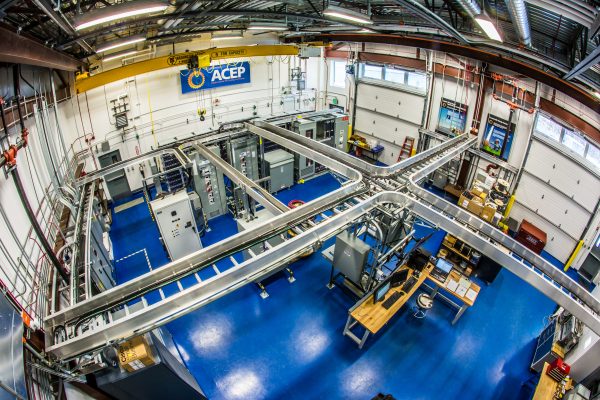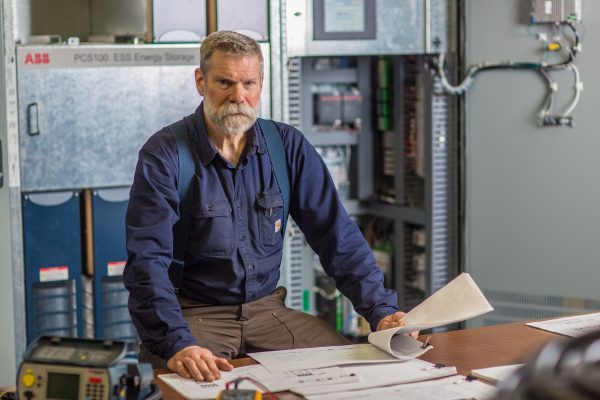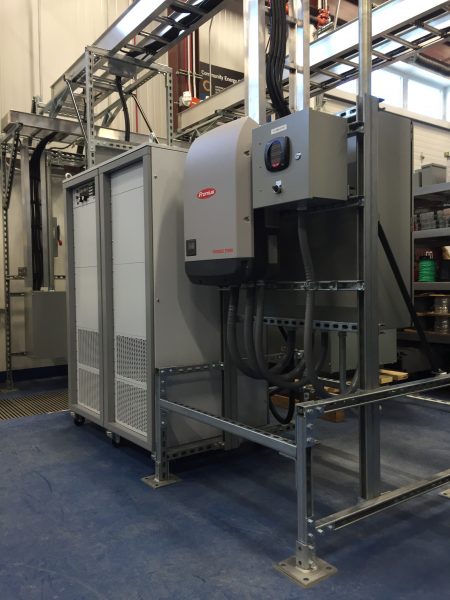A village in a lab: UAF works to advance energy industry
May 25, 2016
Max Frey
907-474-1143

The first thing you notice upon entering the 5,000-square-foot Energy Technology Facility located on the University of Alaska Fairbanks campus is the bright blue UAF-colored floor and the orderliness of everything inside. All four bays of the world-class energy lab are dedicated to the design and development of practical, cost-effective and innovative energy solutions for Alaska.
The efficiency and effectiveness of the space is a testament to the hours of hard work and years of field experience on the part of the laboratory manager, David Light, and a robust team of researchers working for the Alaska Center for Energy and Power.
Light’s expertise is most evident inside the middle bays of the facility, where the Power Systems Integration Laboratory is located. The PSI lab is designed to operate on the same scale as a typical rural Alaska village power system and can be modified for multiple testing scenarios. Through several years of concentrated teamwork (and with the help of a 5-ton overhead crane), the lab was transformed from an empty test space in 2011 into a state-of-the-art microgrid testing environment. Its equipment includes a cutting-edge inverter, a 320 kilowatt generator, a high-resolution data acquisition system and more.

This year, the PSI lab is adding two more emulators — devices that mimic the behavior of energy systems. (The lab already has a wind turbine emulator.)
The new solar photovoltaic emulator is a direct-current power source allowing researchers to model the effects of sudden drops or rises in electricity created by a solar panel array in a microgrid environment, such as found in an Alaska village.
“This will be online very shortly, and will enable us to provide a realistic solar resource for use in our research,” Light said.
Just outside the facility sits an imposing steel structure awaiting the arrival of the next lab addition, a specially designed electrical fault emulator. This fault emulator will allow ACEP researchers to create electrical faults, typically dangerous and damaging events, in a controlled environment in order to collect data on the effects of faults in isolated electrical grids. The fault emulator is under construction, with completion scheduled by late summer, Light said.

The research results produced by ACEP’s PSI lab are providing crucial information to managers of rural Alaska communities as well as the quickly growing, billion-dollar microgrid industry that supports them. Clay Koplin, the CEO of Cordova Electric Cooperative, called ACEP “a high functioning unit” that helps his co-op with its complex technical challenges.
To promote this research, the U.S. Economic Development Administration selected ACEP and its partners as one of 26 winners of an i6 Challenge Award. The $1 million, three-year award is being used to establish the Alaska Center for Microgrid Technologies Commercialization, which will operate out of ACEP’s PSI Program at UAF.
ACMTC provides streamlined access to the extensive knowledge network of utilities and companies operating in more than 200 remote Alaska communities, as well as providing laboratory time for technology research and development. It also offers testing on equipment such as the solar and fault emulators, which were both funded through the i6 Challenge Award.
The focus of ACMTC is to provide technical and business assistance to industry members to bring their microgrid products or services to market. The first step is to document the critical issues and challenges that industry members and technology innovators can encounter in rural and isolated settings. Being able to address these issues successfully will allow developers to more effectively deploy their products and services into the Alaska microgrid market.
ADDITIONAL CONTACT: George Roe, gmroe@alaska.edu


